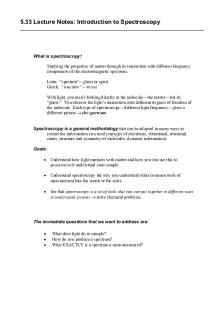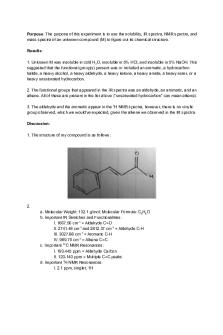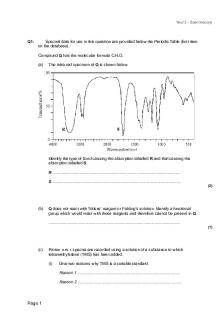Sunscreens and Ultraviolet Spectroscopy PDF

| Title | Sunscreens and Ultraviolet Spectroscopy |
|---|---|
| Author | Maggie Tran |
| Course | (CHEM 2125, 2225, 2425) Organic Chemistry Laboratory |
| Institution | Texas A&M University |
| Pages | 4 |
| File Size | 103 KB |
| File Type | |
| Total Downloads | 68 |
| Total Views | 165 |
Summary
Laboratory Report Assignment of Lab #2 that all CHEM 238 students had to do. This is the final copy of the report submitted, I got a 36/40 on this assignment...
Description
Sunscreens and Ultraviolet Spectroscopy Results I tested Solution 3 - Coppertone Sport Sunblock Lotion (SPF 75) UVA/ UVB and it had an absorbance value of 0.479 at 310 nm and 0.191 at 360 nm. After the UV spectrums of all of the sunscreen samples were taken, the results were recorded in the table shown below in Figure 1. Solution 8 - Neutrogena UltraSheer Dry-Touch Sunscreen with helioplex (SPF 45) UVA/UVB, Solution 9 - Neutrogena UltraSheer Dry-Touch Sunscreen with helioplex (SPF 70) UVA/UVB, Solution 10 - Bull Frog Quickgel Sunscreen (SPF 50) UVA/ UVB, and Solution 7 - Neutrogena UltraSheer Dry-Touch Sunscreen with helioplex (SPF 30) UVA/UVB had the highest absorptions at 310 nm. All of these sunscreens that had the highest absorption values contained the same active ingredients as seen in Figure 2. Solution 8 - Neutrogena UltraSheer Dry-Touch Sunscreen with helioplex (SPF 45) UVA/UVB, Solution 9 - Neutrogena UltraSheer Dry-Touch Sunscreen with helioplex (SPF 70) UVA/UVB, Solution 7 - Neutrogena UltraSheer Dry-Touch Sunscreen with helioplex (SPF 30) UVA/UVB, and Solution 1 - Coppertone Sport Sunblock Lotion (SPF 15) UVA/ UVB had the highest absorbance at 360 nm. Solution 5 - Banana Boat Sport Performance Sunscreen Lotion (SPF 30) UVA/UVB and Solution 2 Coppertone Sport Sunblock Lotion (SPF 50) UVA/ UVB had the lowest absorbance values at 310 and 360 nm. In order to determine the best and worst sunscreens, the results were averaged. In cases where one data point appeared to be an outlier, the outlier was not considered in averaging. All of the data gathered in the experiment is listed below in Figure 1.
Figure 1: Absorbance values found when the UV spectrum of each sample was taken. Absorbance Values Found Solution Absorbance at Average of Absorbance at Average of Number 310 nm (UVB) Absorbance at 360 nm (UVA) Absorbance
310 nm (UVB) 1 2 3 4 5 6 7 8 9 10
0.494, 0.172, 0.499 0.700, 0.370, 0.355 0.480, 0.922, 0.478 0.415, 0.121, 0.441 0.203, 0.209 0.217, 0.557 0.392, 0.729 0.933, 0.863 0.735, 0.452 0.725, 0.324
0.497 0.363 0.479 0.428 0.206 0.387 0.561 0.898 0.594 0.525
0.413, 0.087, 0.414 0.517, 0.193, 0.184 0.196, 0.599, 0.185 0.373, 0.064, 0.380 0.070, 0.070 0.106, 0.432 0.237, 0.576 0.702, 0.649 0.544, 0.249 0.523, 0.120
at 360 nm (UVA) 0.414 0.189 0.191 0.377 0.070 0.269 0.407 0.676 0.397 0.322
Figure 2: Comparison of the different ingredients found in the sunscreen samples tested in the experiment. An X in the box indicates that the sunscreen sampled contained that ingredient. Solution Number Ingredients 1 2 3 4 5 6 7 8 9 10 Octocrylene X X X X X X X X X X Oxybenzon X X X X X X X X e Ethylhexyl X X X X X X X X X Salicylate Homosalate X X X X X X X X X X Avobenzone X X X X X X X X X X
Discussion After comparing each sunscreen’s absorbance level, it was determined that Solution 8 Neutrogena UltraSheer Dry-Touch Sunscreen with helioplex (SPF 45) UVA/UVB was
the best sunscreen because it had the highest absorbance values at 310 and 360 nm. It is likely that this was the best sunscreen due to it containing all of the active ingredients, especially homosalate and oxybenzone, which help it to absorb UVB light that is know to cause intense sunburn and skin cancer. Homosalate absorbs between 295 and 315 nm and oxybenzone absorbs between 270 and 350 nm. UVB light falls between both of the ranges at an absorbance of 310 nm, which allows these ingredients to absorb this harmful light. Avobenzone absorbs between 320 and 400 nm and has a consistent percentage in all of the sunscreens except for Solution 5 - Banana Boat Sport Performance Sunscreen Lotion (SPF 30) UVA/UVB that only contained 1% where almost all others contained 3%. Solution 5 was the worst sunscreen because it did not have enough avobenzone to absorb the UVA light, which is absorbed at 360 nm. The larger the organic molecule and the more conjugation it has, the higher wavelength it absorbs. In this case, a very large or a very small molecule would not be able to absorb up to 310 nm or could be too high to absorb 360 nm in order to absorb UVA and UVB light. Avobenzone is a large molecule with a lot of conjugation of carbon-carbon double bonds that allow it to absorb at a higher wavelength, 320-400 nm. This allows avobenzone to easily absorb UVA light. Homosalate has a similar size to avobenzone but has less conjugation so it absorbs light at 295-315 nm, which is optimal for absorbing UVB light. Oxybenzone is slightly smaller than avobenzone but is highly conjugated so it absorbs at 270-350 nm, which is also optimal to absorb UVB light. A practical application of UV-vis spectroscopy is shown in this experiment. The absorption of substances can be determined so that they can be used for purposes like absorbing harmful UVA and UVB lights so that it lessens the penetration into human skin. This can help prevent skin problems including sunburn, cancer, wrinkles and aging as well as cataracts and immunosuppression. Some sources of error in this experiment could have occurred from the sunscreen solution being slightly overfilled with isopropyl alcohol, which would have diluted the sunscreen too much and caused the absorption to be less than it actually is. Isopropyl alcohol also evaporates very quickly so if the vial was not kept covered, it could have evaporated out and caused the absorbance to be greater than it actually was because it was less diluted.
Conclusions The optimal substances for absorbing UVA and UVB light have an absorption range that includes 310 and 360 nm. A larger and more conjugated molecule will absorb higher wavelengths so it is important to have a molecule that is the size and conjugation that is
relevant to what wavelength needs to be absorbed. UV spectroscopy can be used for practical purposes such as determining organic molecules that can absorb harmful UVA and UVB light to help cover skin and protect it from harmful waves....
Similar Free PDFs

Spectroscopy
- 5 Pages

Mass Spectroscopy
- 14 Pages

Spectroscopy Lab
- 2 Pages

Raman Spectroscopy
- 22 Pages

Spectroscopy Questions
- 116 Pages

Infrared Spectroscopy
- 3 Pages

Spectroscopy+EC 0002a
- 1 Pages

Introduction to Spectroscopy 1
- 3 Pages

Atomic Absorption Spectroscopy
- 271 Pages
Popular Institutions
- Tinajero National High School - Annex
- Politeknik Caltex Riau
- Yokohama City University
- SGT University
- University of Al-Qadisiyah
- Divine Word College of Vigan
- Techniek College Rotterdam
- Universidade de Santiago
- Universiti Teknologi MARA Cawangan Johor Kampus Pasir Gudang
- Poltekkes Kemenkes Yogyakarta
- Baguio City National High School
- Colegio san marcos
- preparatoria uno
- Centro de Bachillerato Tecnológico Industrial y de Servicios No. 107
- Dalian Maritime University
- Quang Trung Secondary School
- Colegio Tecnológico en Informática
- Corporación Regional de Educación Superior
- Grupo CEDVA
- Dar Al Uloom University
- Centro de Estudios Preuniversitarios de la Universidad Nacional de Ingeniería
- 上智大学
- Aakash International School, Nuna Majara
- San Felipe Neri Catholic School
- Kang Chiao International School - New Taipei City
- Misamis Occidental National High School
- Institución Educativa Escuela Normal Juan Ladrilleros
- Kolehiyo ng Pantukan
- Batanes State College
- Instituto Continental
- Sekolah Menengah Kejuruan Kesehatan Kaltara (Tarakan)
- Colegio de La Inmaculada Concepcion - Cebu






